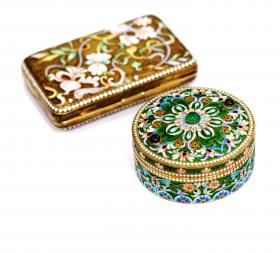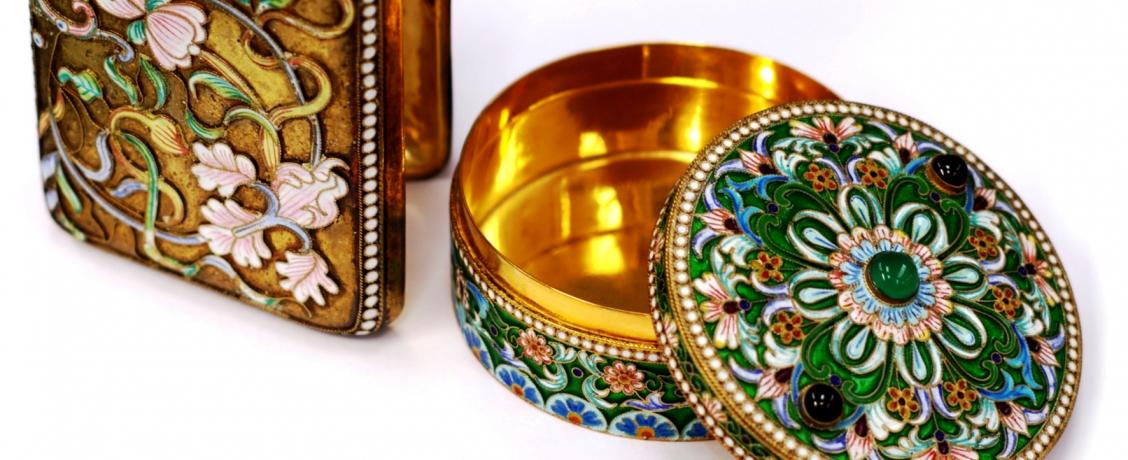Going for Gold in Russia
Going for Gold in Russia
Art Nouveau was an international art movement, but it developed unique national features in each and every country where it took hold. Art Nouveau came to Russia from Europe and penetrated many art fields. This style, which combined beauty and functionality and referenced the aesthetics of natural patterns and shapes, impacted on how buildings were built, influenced the design of interiors and inspired popular fashions and personal accessories.
St. Petersburg, on the River Neva, provided the dynamic hub for it development in Russia. The city held themed exhibitions from which artists and designers took creative inspiration; foreign companies set up branches in St Petersburg specifically for the production of household items to provide “beautiful life in a beautiful house”; and it was here the World of Art magazine was published, a revered journal which launched, charted and celebrated the visions, aspirations and achievements of high end art, craft and design that was leading the way in the Art Nouveau movement.
Russia’s Art Nouveau heritage is superb, but it is her jewellery firms that have long been recognized as among the leaders of Art Nouveau artisans. They widely used fine expressive lines, floral motifs, and developed their own “original Russian style” within Art Nouveau. Art pieces by Russian masters were a great success at international exhibitions, invariably impressing the European public by a very recognisable national interpretation of Art Nouveau.
Famous names such as Karl Faberge, I. Khlebnikov, F. Lorie, O. Kurlyukov, and N. Nemirov-Kolodkin included prominent silversmiths and goldsmiths of the period, and whilst one of the most striking implementations of Art Nouveau in Russian decorative art was the works of the ceramic workshop of the Imperial Stroganov School, Art Nouveau first and most clearly manifested itself in the work of gold and silversmiths and jewellers.
With this historical background in mind, two lots entered for sale at the next Quarterly Special Antiques Sale at the Diss Auction Rooms of TW Gaze on 29 June stand out as worth a mention: a silver gilt and enamelled cigarette case and a silver gilt and enamelled lidded box set with three coloured semi-precious cabochons to the top. Both are Russian, both date from between 1908 and 1917 and both are exquisitely decorated in the Art Nouveau taste.
They do not bear an attributable maker’s mark, but each hall mark contains, as it should, two digits which represent the number of zolotniks per pound of alloy. What is a Zolotnik? It is a Russian unit of weight approximately equivalent to 4.27 grams. (It was rendered obsolete when the Soviet Union began to use the metric system in 1924.) Here the number is 84 and represents the standard of fineness. 84 zolotniks, the most commonly used standard, was fixed in an act passed on 9 February 1882 and brought into force on 1 July 1896. In the same year a national mark was also introduced. It consisted of the left profile of a woman’s head wearing a diadem, changing in 1908 until 1917, to the woman’s head looking to the right. The pieces here bear this latter mark, and combined with the high Art Nouveau influence in decoration, place them firmly in the prime time of production.
The decoration is enamelled and the brightness of the yellow gilt makes an excellent foil to the vibrancy and freshness of the enamel colours. There are approximately 14 types and methods of enamelling which have been used throughout the world over the centuries. Enameling as an art form has been around for thousands of years; however, the enamel masters working in Russia in the late 19th and early 20th Centuries brought the process to an entirely new level of creativity, complexity and beauty. Russian enamels are some of the most intricate, complex and beautiful works of art that have ever been created. Many of the most important pieces were made between 1870 and 1917 in Moscow and St Petersburg by a variety of highly imaginative and exceptionally skilled artists and craftsmen, who employed different techniques of enameling, including champlevé, plique-a-jour, en-plein painted enamel, guilloche, cloisonné and most often, shaded cloisonné.
Both items here are decorated with cloisonné enamel. Often popularly associated with art works form China and Japan, but actually found world-wide, it takes its name from the French “cloison”, being = "cell" or "partition". It is a technique in which flattened wires are placed in a pattern on a base metal sheet. These wires form compartments and they are either soldered or glued in place with an unobtrusive gum which burns away during firing. When the design is finished, the compartments are filled with prepared glass of different colours and fired at temperatures between 700 and 900 degrees Celsius.
The pre-auction estimate is £400 – 600 for each item. These, plus many more amazing artefacts can be found in the catalogue posted a few days before auction www.twgaze.co.uk. Viewing will be Thursday 28 June 2 – 8pm and on morning of the sale from 8.30am. Auction starts at 10.30am and will be supported by the live bidding platform www.the-saleroom.com.
By Elizabeth Talbot

